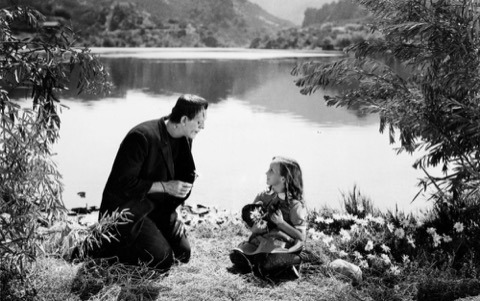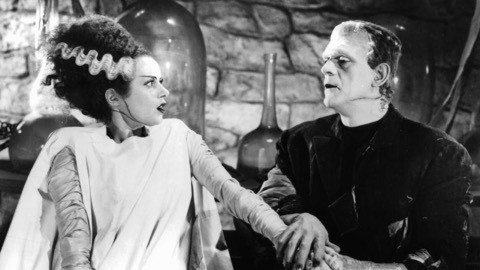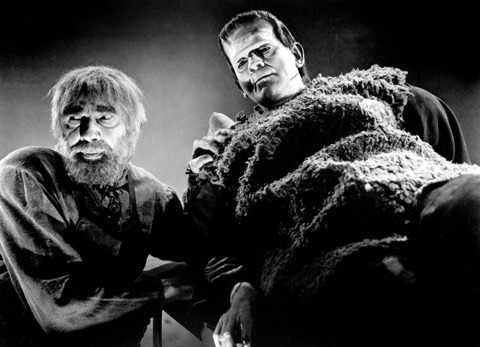Part 1 – The Universal Years
Even in the formative years of the cinema, when films were rarely any longer than two reels, Mary Shelley’s extraordinary story did not escape the attention of movie makers and the first screen version appeared, courtesy of the Edison company, in 1910. Starring a certain Mr. Charles Ogle in grotesque make-up and sporting some primitive but nonetheless impressive special effects, the film was thought to be lost for many years. However, parts of it, if not all, have survived and clips were used by Christopher Frayling in his excellent 1996 BBC TV documentary series “Nightmare: the Birth of Horror”.
But, this film apart, it was not until 1931 that the story of “Frankenstein” really hit the silver screen in Universal Pictures’ now classic movie, with Colin Clive as the eponymous scientist and with English director James Whale at the helm. The film also made an overnight star of a hitherto busy but little known actor, another Englishman, who revelled in the real name of William Henry Pratt but who is now remembered the world over as Boris Karloff. His sympathetic characterisation of the tormented creation, together with Jack Pierce’s spectacular and unforgettable make-up, ensured the film’s immediate success and, along with Bela Lugosi’s Dracula (made the same year), guaranteed the future of the horror genre in the cinema.

Boris Karloff as the Monster with Marilyn Harris
in Frankenstein (1931)
Over the next four years, Universal tapped the fantasy market again and again with such productions as Murders in the Rue Morgue (1932), The Mummy (1932), The Old Dark House (1932), The Invisible Man (1933) and The Black Cat (1934), but it was not until 1935 that they hit upon the idea of a sequel to Frankenstein and gave James Whale the directorial reins again for Bride of Frankenstein. The film is presented as though its plot were written by Mary Shelley herself and indeed the prologue shows her beginning to tell the sequel to Byron and Shelley, her companions when writing the original novel. Once again, Frankenstein is played by Colin Clive and Boris Karloff is the monster, who has survived his supposed fiery demise in the first film by plunging into an underground reservoir beneath the windmill. This presented Universal with a problem and, in order to give continuity with the original, the studio hurriedly excised the happy ending of the film, in which Colin Clive is seen sitting up in bed and recovering from his ordeal, from as many of the prints of the film as they could; fortunately, however, the scene survived and it has been re-inserted into most copies now shown. Bride of Frankenstein is pervaded by a dark and quirky sense of humour, particularly in the performances of Ernest Thesiger as the unhinged Doctor Pretorius and Una O’Connor as Frankenstein’s hysterically raucous housekeeper, and Karloff certainly meets his match with the all too brief, but very impressive, appearance of Elsa Lanchester as his prospective mate (she also plays Mary Shelley in the prologue).

Elsa Lanchester and Boris Karloff in
Bride of Frankenstein (1935)
Another four years passed before Universal made the next film in the series, Son of Frankenstein (1939, directed by Rowland V. Lee), starring Boris Karloff as the monster (for the last time), Basil Rathbone replacing Colin Clive by playing his son, Bela Lugosi as the mad Igor and Lionel Atwill as the one-armed police inspector. The film is graced with some superb overacting and is the last of the Universal Frankenstein productions with any real class, as lower budgets and some pretty second-rate stories took over, beginning with The Ghost of Frankenstein (1942, directed by Erle C. Kenton), in which Cedric Hardwicke’s Frankenstein inadvertently transplants Igor’s brain into the monster, played for the only time by Lon Chaney, Jr. Unfortunately, Igor’s and the monster’s tissue types do not match and the creature ends up blind!
The ending of “Ghost” would have neatly explained why in the next film, Frankenstein Meets the Wolf Man (1943, directed by Roy William Neill taking a break from his Sherlock Holmes series), Bela Lugosi plays a stumbling, clumsy monster, as though he were groping round in the dark, which is of course precisely what he is meant to be doing. It would also have gone some way to explaining why Lugosi, who was not really suited to the part, was cast as the monster in the first place. However, Universal, for reasons best known to themselves, deleted the explanation from the final version of the film, with the result that, to anyone who has not seen The Ghost of Frankenstein, the creature’s reactions and awkward gait in the sequel appear (perhaps unfairly) to be due to some rather bad acting from Lugosi! The story mainly concerns the plight of Lawrence Talbot, alias the Wolf Man (Lon Chaney, Jr. reprising the role he had first played in 1941’s The Wolf Man, directed by George Waggner). Accidentally revived from his tomb in the tiny Welsh village of Llanwelly, Talbot makes his way to Europe in a desperate search for Frankenstein, who he hopes will be able to do something to help his accursed condition. When he eventually arrives at the castle, he finds that the Baron is dead but that his creation is still very much alive, setting the scene for a climactic battle between the two great monsters, which ends as the local villagers blow up the dam above the castle and unleash a raging torrent which apparently drowns them both. Although overall a little disappointing, a definite point in the film’s favour is that it features the welcome return of actress Maria Ouspenskaya, again turning in a fine performance as the old gypsy woman Maleva, Talbot’s mentor from The Wolf Man.

Bela Lugosi and Boris Karloff in
Son of Frankenstein (1939)
